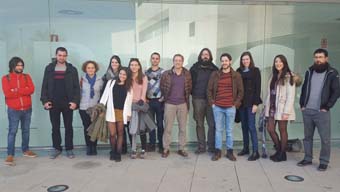
The Universitat de València, different hospitals, FISABIO and the Health Institute Carlos III have taken part in a study that has characterised at the Valencian Community level which are the main existing types of the Human Immunodeficiency Virus (HIV) as well as which are the main risk groups of the infection epidemic. The work has been published today in the ‘Scientific Reports’ magazine and it is based on samples obtained between the years 2004 and 2014 in Valencian hospitals and UPSI.
‘Most of the studied cases correspond to groups of transmission chains within the Valencian Community. This proves the importance of the local transmissions’, has highlighted Fernando González, full university professor of the Universitat de València, coordinator of the work and researcher at FISABIO (Foundation for the Promotion of the Health and Biomedical Research at the Valencian Community).
The research illustrates that 57% of the infections correspond to transmission groups of the Valencian Community in which the infections of Spanish men who have unprotected sexual relations with men predominate. Moreover, it proves that the non-B subtypes described in the Valencian level mainly affect heterosexual people of foreign origin. Even though the impact is smaller, among the people affected by the B subtype there are also drug users that take intravenously administered drugs.
Furthermore, the study describes a steady increase of the non-B infections (more than 15%) as a consequence of the flows of people such as immigration and tourism. This fact has been previously confirmed in other Spanish regions like the Community of Madrid. As for the B type of HIV, in line with the existing data at a European level, it is also prevalent in most occidental countries. Therefore, this is the most studied type and for which the virus mutations that can provoke resistance to the antiretroviral agents are better known.
The innovative aspect of this study, ‘The molecular epidemiology of HIV-1 in the Comunidad Valenciana (Spain): analysis of transmission clusters’, is that it has been carried out by analysing the genetic information of the virus in 1,804 samples of six hospitals and UPSIs (Units for AIDS prevention and other STIs) in contrast to other works that are based on interviews. The samples have been generated from mid-2000 to beginning of 2014.
This methodology aims at designing the best antiviral therapy for each infected person and it is combined with epidemiological and clinical data within a programme of epidemiological surveillance of the IHV infection. The objective is to find a more detailed and accurate characterisation of the IHV epidemic in the Valencian Community.
According to Fernando González, this research is relevant ‘due to the greater resolution and detail that it provides to the surveillance of the virus infection by describing and quantifying the existence of transmission groups. In addition to this, it allows to design and implement information and control programmes addressed to the most vulnerable groups’. The work highlights that the obtained results ‘should be useful to stablish and strengthen the preventive measures in certain risk groups’.
Research
This research has been funded by the Economy and Competitiveness, Health and Consumption, and the Culture and Sport ministries as well as by the PROMETEO programme (Valencian Government) for excellent research groups.
Article:
Patiño-Galindo et al. (2017) «The molecular epidemiology of HIV-1 in the Comunidad Valenciana (Spain): analysis of transmission clústers». Sci. Rep. 7, 11584. (http://www.nature.com/articles/s41598-017-10286-1)
Last update: 14 de september de 2017 13:40.
News release



















